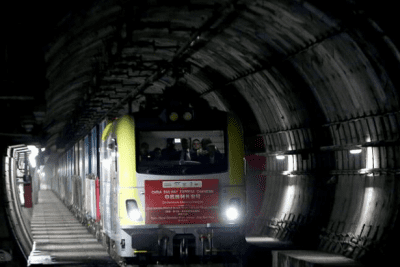Chinese Use of Marmaray Subsea Tunnel Another First for Belt and Road Initiative
Publication: Eurasia Daily Monitor
By: John C. K. Daly
The Jamestown Foundation

On November 7, at 3:30 A.M., a westbound train from Xi’an, China, for the first time ever used Istanbul’s $4 billion Marmaray sub-Bosporus railway tunnel to dispatch goods to central Europe (Haber.sol.org.tr, November 7). The train’s voyage represents another of China’s attempts to shave time off its trans-Eurasian rail shipments; the train crossed 2 continents, 10 countries, 2 seas and 7,135 miles of railway in 12 days.
Organized by China Railway Express and carrying 42 twenty-foot equivalent unit (TEU) containers, each packed with 76 cubic meters of high-value, low-volume electronics, the train started in Xi’an in central China, crossing Kazakhstan before being loaded on an Aktau train ferry to cross the Caspian to Baku. From there, it proceeded to Turkey via the Baku–Tbilisi–Kars (BTK) Railroad (Star.com.tr, November 8). Upon arriving in Istanbul, the train traveled northward to Kapıkule, on Turkey’s Bulgarian border, before continuing onward to Prague.
The Marmaray passage underlines the growing potential of the Trans-Caspian Silk Road “Middle Corridor” rail route—Turkey’s vision for connecting China to Europe via Central Asia and the South Caucasus. Also known as the “Trans-Caspian International Transport Route” (TITR), the corridor’s genesis dates to 2015, when Turkey and China signed a memorandum of understanding to align Turkey’s Middle Corridor initiative with the China’s One Belt, One Road (OBOR—since renamed the Belt and Road Initiative or BRI), coordinating transportation and logistics cooperation.
Two days before the train’s passage via the Marmaray tunnel, Turkish Minister of Transport and Infrastructure Cahit Turhan noted this would be the first time that a train sent from China to Europe would be utilizing Turkey’s “Iron” Silk Road middle corridor. Moreover, he pointed out that it would be “the first international freight train to pass through Marmaray” (Aydınlık, October 28). Later, at a ceremony celebrating the train’s arrival in the Turkish capital of Ankara, Minister Turhan addressed the implications for Turkey of Eurasia’s broadening trade routes: “Considering the $21 trillion trade volume between Asia and Europe, the importance of the issue will be easily understood. The Iron Silk Road line, which benefits a population of nearly 5 billion and 60 countries, has become a new and a very important alternative for the global commercial network” (The Daily Sabah, November 7).
Turkish Economic Policy Research Institute (TEPAV) senior researcher Sait Akman commented on the Marmaray passage, arguing, “It is progress [that] is in line with Turkey’s expectations.” He added that an additional benefit could be that the train’s successful passage may stimulate additional Chinese investment in Turkey’s railway infrastructure, which is in need of improvement from Kars to Edirne (XinhuaNet, November 8).
The Marmaray shipment illustrates both the rising value of the TITR and the future value of the BTK railway line (opened in 2017) in expanding freight transport between China and Europe. Statistics are already bearing this out: in 2014, only 100 TEUs were transported along the TITR. Following the formal opening of the BTK railroad in October 2017, TITR cargo transport in 2018 rose to 15,000 TEUs. And by 2019, 60,000 TEU of cargo has traveled across this increasingly prominent route (Middlecorridor.com, accessed November 21).
Interest in the TITR goes beyond China, Central Asia and Turkey; it has notably been identified as an important element of the European Union’s multifaceted efforts to decrease its members’ dependencies on Russia. Specifically, China’s utilization of the Marmaray Tunnel will permit nonstop transit from the Caspian directly through to Europe for Chinese freight companies, completely bypassing the Russian Federation and its cumbersome sanctions on the import and transit of numerous EU products. Accordingly, on February 28, representatives from the EU and Turkey signed a €275 million ($305 million) grant to support the €1 billion ($1.11 billion) modernization of the 145-mile Istanbul–Kapıkule Railway, which Brussels identifies as a significant link within the core trans-European railway network. The funds will allow for the electrified mixed-traffic line to be double-tracked and equipped with the European Train Control System (ETCS) Level 1, allowing trains to operate at up to 125 miles per hour (The Railway Gazette, March 1).
The EU initiatives dovetail nicely with Turkey’s own infrastructure upgrade plans. As noted by Transport and Infrastructure Minister Turhan, Turkey is determined to increase its percentage of the $21 trillion Eurasian transit trade by continuing to upgrade its railway network. Fatih Erdoğan, the head of the logistics company Pasifik Eurasia, which supervised the China Railway Express transit via Marmaray, noted that, at present, only 3 percent of the China–Europe trade is transported via rail (The Daily Sabah, November 5).
Of course, while the EU is focused primarily on the bloc’s economic interactions with China, the North Atlantic Treaty Organization (NATO) takes a less benign view of China’s increasing economic and military power. Railways are notably “dual use,” able to function in both economic and military contexts. In late November, and ahead of the upcoming (December 3–4) summit in London, NATO foreign ministers convened to consider an agenda which included, inter alia, “the implications of the rise of China” (Nato.int, November 19). It is safe to assume that China’s use of Marmaray and its “implications” were probably raised during those discussions.
The Jamestown Foundation kindly allows Modern Tokyo Times to publish their highly esteemed articles. Please follow and check The Jamestown Foundation website at http://www.jamestown.org
https://twitter.com/JamestownTweets The Jamestown Foundation
Photo source: The photo in this article is the original image uploaded by The Jamestown Foundation (source: sol)